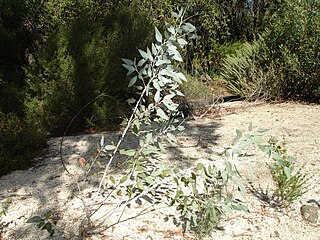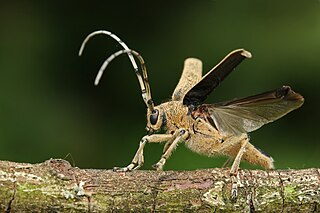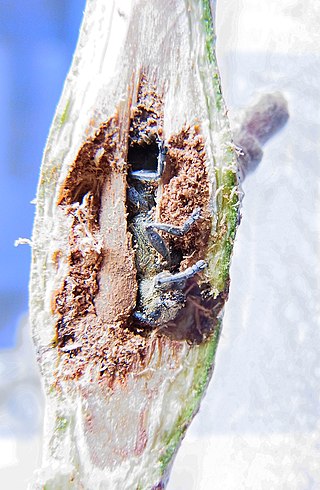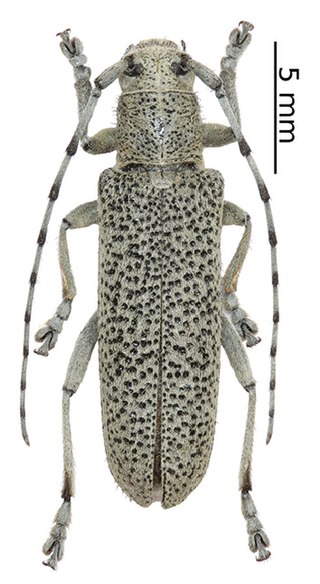
Eucalyptus cretata, commonly known as Darke Peak mallee or chalky mallee, is a species of mallee or, rarely, a small, straggly tree and is endemic to a restricted part of South Australia. It has smooth whitish and grey bark, lance-shaped adult leaves, glaucous flower buds in groups of seven, white flowers and cup-shaped to barrel-shaped or conical fruit.
Euproctosia is a genus of moths in the subfamily Arctiinae. It contains the single species Euproctosia cretata, which is found in Ghana.

Acontia cretata, the chalky bird dropping moth, is a moth of the family Noctuidae. The species was first described by Augustus Radcliffe Grote and Coleman Townsend Robinson in 1870. It is found from the US states of California to Texas and Oklahoma, north to Colorado and Utah.

Saperda carcharias is a species of longhorn beetle.

Saperda is a genus of flat-faced longhorn beetles belonging to the family Cerambycidae, subfamily Lamiinae. The genus was erected by Johan Christian Fabricius in 1775.
Eupithecia cretata is a moth in the family Geometridae first described by George Duryea Hulst in 1896. It is found in the US state of Colorado.

Saperdini is a tribe of longhorn beetles of the subfamily Lamiinae.
Rhytiphora cretata is a species of beetle in the family Cerambycidae. It was described by Francis Polkinghorne Pascoe in 1859. It is known from Australia.

Saperda calcarata, the poplar borer, is a species of beetle in the family Cerambycidae. It was described by Thomas Say in 1824. It is known from Canada and the United States. It contains the varietas Saperda calcarata var. adspersa.

Saperda candida, the roundheaded appletree borer, is a species of beetle in the family Cerambycidae. It was described by Johan Christian Fabricius in 1787. It is known from Canada and the United States. It contains the varietas Saperda candida var. bipunctata.
Saperda fayi is a species of beetle in the family Cerambycidae. It was described by Bland in 1863. It is known from Canada and the United States.
Saperda horni is a species of beetle in the family Cerambycidae. It was described by Joutel in 1902. It is known from Canada and the United States. The species name is often misspelled as hornii.
Saperda interrupta is a species of beetle in the family Cerambycidae. It was described by Gebler in 1825. It is known from China, Russia, Siberia, Korea and Japan. It is associated with coniferous plantations, and infests species of fir, pine, spruce and other conifers.
Saperda lateralis is a species of beetle in the family Cerambycidae. It was described by Johan Christian Fabricius in 1775. It is known from Canada and the United States.

Saperda perforata is a species of beetle in the family Cerambycidae. It was described by Pallas in 1773, originally under the genus Cerambyx. It has a wide distribution in Europe. It feeds on Populus nigra, Populus alba, and Populus tremula. It is preyed upon by the parasitoid wasp Xorides indicatorius.

Saperda populnea, the small poplar borer, is a species of beetle in the family Cerambycidae which forms woody galls on twigs of poplars and willows. It was described by Carl Linnaeus in 1758.

Saperda quercus is a species of beetle in the family Cerambycidae. It was described by Charpentier in 1825. It is known from Turkey, Romania, Bosnia and Herzegovina, Jordan, Serbia, Bulgaria, Greece, Syria, and possibly Hungary. It feeds on Quercus coccifera.

Saperda scalaris is a species of beetle in the family Cerambycidae. It was described by Carl Linnaeus in 1758, originally under the genus Cerambyx. It has a wide distribution in Europe and Asia. It is preyed upon by parasitoid wasp species including Xorides praecatorius and Helcon angustator.

Saperda similis is a species of beetle in the family Cerambycidae. It was described by Laicharting in 1784. It has a wide distribution in Europe. It feeds on Salix caprea. It contains the varietas Saperda similis var. albopubescens.

The elm borer is a species of beetle in the family Cerambycidae. It was described by Guillaume-Antoine Olivier in 1795. It is known from Canada and the United States. It feeds on Ulmus rubra and Ulmus americana. It acts as a vector for the fungus Ophiostoma ulmi, and as a host for the parasitoid wasp Cenocoelius saperdae.












